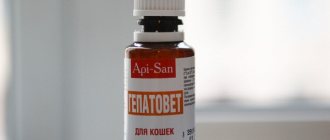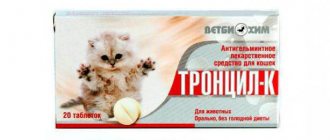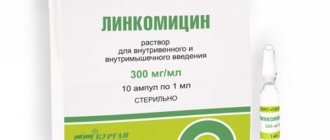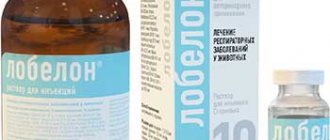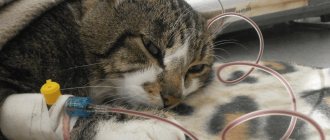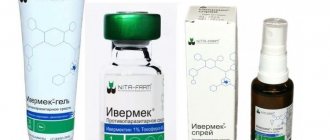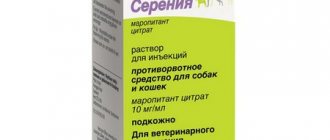Composition and action
The active ingredients of the homeopathic medicine are:
| Celandine (chelidonium) | A medicinal plant that has long been known in medicine, and Paracelsus also used an infusion of celandine as an analgesic for colic, bile fever and liver diseases; club moss (lycopodium) - spores or herbs have anti-inflammatory, antispasmodic, analgesic effects, in folk medicine and homeopathy they are used as part of medicines for liver diseases, colic, spasms; |
| Thistle | Or milk thistle is used for liver disorders, hepatic congestion, jaundice due to infectious hepatitis and other diseases; Colocynth is a plant of the watermelon genus with fruits resembling a pumpkin. The plant is poisonous, but in homeopathic doses it can benefit the body. Has anti-inflammatory, antispasmodic effects; |
| Colocynthus | A plant of the watermelon genus with fruits resembling a pumpkin. The plant is poisonous, but in homeopathic doses it can benefit the body. Has anti-inflammatory, antispasmodic effects; |
| Taraxacum | Common dandelion, which is used in homeopathy as part of preparations for the treatment of the liver and gallbladder; |
| Veronica officinalis | A plant that is used in folk medicine and homeopathy as an anti-inflammatory agent for kidney inflammation and liver diseases. |
Veterinarians recommend Covertal for the treatment of pets suffering from chronic liver diseases and acute inflammatory processes. The drug helps normalize the functioning of liver tissue.
Instructions for use
In order to open a bottle of solution, it is important to first remove the protective layer from the foil. You can draw the solution into a syringe without uncorking the rubber stopper; just wipe it with an alcohol solution and then pierce it with a needle. Then you can draw the required amount of the drug into the syringe.
It is allowed to give injections to the cat under the skin in the withers area or in the femoral muscle. The first option is more preferable, since the pet behaves calmly when taken by the withers.
It is important to follow a strict injection schedule. Because if you miss at least 1 injection, the effectiveness of treatment is significantly reduced.
Video subcutaneous injection at home
Purpose
Homeopathic medicine is used as an effective drug:
- for hepatitis;
- toxic liver damage;
- degeneration of fatty liver tissue;
- infectious diseases that occur in severe form and are characterized by liver damage;
- infestations
The liver is a vital internal organ that performs important functions in the body: it participates in hematopoiesis, ensures the removal of toxins from the body, the production and storage of fats, carbohydrates and important enzymes involved in the processes of food digestion, metabolic processes and blood purification. Liver diseases can result in disastrous consequences for your pet, with premature death, so it is important to contact a veterinarian at the first symptoms of organ damage.
Liver pathologies can be acute or chronic. Dangerous acute diseases include infectious hepatitis and leptospirosis. When dangerous viruses enter an animal’s body, the liver may be damaged. Hepatitis is a contagious disease manifested by dysfunction of the liver and gastrointestinal tract, fever, and damage to the central nervous system.
Leptospirosis is an infectious disease carried by rodents. The pathology is manifested by refusal of food, increased temperature, and ulceration of the oral cavity. Treatment of acute illness requires the use of strong antibiotics.
Chronic liver pathologies are often the result of anatomical disorders. Diseases can be of a secondary nature; they can be caused by the presence of malignant tumors (not only in the liver, but also in other organs), inflammatory processes in the dog’s body, autoimmune diseases, and pathologies of the bile ducts. Common symptoms of liver disease are:
- refusal to eat or loss of appetite;
- noticeable weight loss;
- lethargy, drowsiness, depression;
- vomit;
- diarrhea;
- increased thirst;
- yellowing of mucous membranes, sclera;
- change in the consistency and color of feces (stool becomes pale).
Older dogs are primarily at risk for chronic liver pathologies, but some breeds, due to anatomical features, have a genetic predisposition to liver diseases. For example, Bedlingtons often suffer from copper toxicosis.
The danger of diseases in which liver function is impaired is that their symptoms do not appear at the stages when the vital organ refuses to work at 80%. The consequences, alas, are sad.
Pancreatitis is a common disease in dogs. This is an inflammation of the pancreas, but it causes dysfunction of the liver, manifested by decreased appetite, shortness of breath, and dehydration - a dangerous symptom that can be fatal.
Important!
The most dangerous liver disease is cirrhosis. Degeneration of organ tissue is possible as a consequence of certain hepatologies and severe intoxications of the body.
Indications for use
Covertal is usually prescribed in combination with other measures and medications. It is considered a concomitant drug for the treatment of the following diseases: Hepatitis, acute and chronic Liver problems due to obesity Various hepatoses (non-inflammatory disorders in liver cells) Diseases caused by parasites - ticks, worms. Liver damage as a result of exposure to poisons and toxins Infectious diseases
Dosage
The injection solution is used 1-2 times a day, the duration of treatment will be determined by the veterinarian, based on the severity of the disease. Usually, for an acute disease, 10-14 injections are sufficient; if the disease has become chronic, the treatment will be long, from 3 to 4 weeks. The drug should be taken until the symptoms of the disease disappear completely. The dosage is determined based on the dog’s weight – 0.1 ml/1 kg of body weight.
Taking the drug has its own characteristics depending on the course of the disease: for acute pathology, injections should be given daily, for chronic disease - 2-3 times a week with equal intervals between injections.
Injections are given subcutaneously or intramuscularly. In the first case, it is better to prick at the withers - inserting the syringe needle at an angle of approximately 45 degrees. Intramuscular injections are placed in the thigh on the hind leg.
Covertal
Instructions for the use of the homeopathic drug Covertal in animals for liver diseases of various etiologies
(Organization - developer: AlexAnn LLC, Moscow region)
I. General information Trade name of the medicinal product: Covertal. International nonproprietary name: not assigned.
Dosage form: solution for injection As active ingredients, Covertal contains components of plant origin (per 1000 ml): Chelidonium majus D12 200 ml; Lycopodium D16 150 ml; Veronica D4 150 ml; Carduus marianus D4 150 ml; Colocynthis D8 150 ml; Taraxacum D4 200 ml and excipients: methyl parahydroxybenzoate - 0.5 g, sodium chloride - 5.8 g, sodium acetate trihydrate - 2.0 g, hydrochloric acid to pH 5.4, ethyl alcohol 95% - 5.26 g , water for injections up to 1000 ml. In appearance, the drug is a colorless transparent liquid.
Covertal is produced packaged in 10 and 100 ml glass bottles, sealed with rubber stoppers and aluminum roll-up caps. Bottles of 10 ml are individually packaged in individual cardboard boxes. Each packaging unit is accompanied by instructions for use.
Covertal is stored in the manufacturer's sealed packaging, separate from food and feed, in a dry place, protected from direct sunlight, at a temperature of 0 to 30°C. The shelf life of the drug, subject to storage conditions in the manufacturer's closed packaging, is 3 years from the date of production, after the first opening of the bottle - 21 days. Covertal must not be used after the expiration date. The cover should be stored in places inaccessible to children. Unused medicinal product is disposed of in accordance with legal requirements.
II. Pharmacological properties Covertal refers to combined homeopathic medicines. The active components included in the drug in homeopathic dilutions contribute to the activation and protection of phospholipid-dependent enzyme systems of hepatocytes, improve the detoxification function of the liver, have a hepatoprotective and anti-inflammatory effect, and have a pronounced antispasmodic and anticholestatic effect.
In terms of the degree of impact on the body, the drug is classified as a low-hazard substance (hazard class 4 according to GOST 12.1.007), and does not have a local irritant or sensitizing effect.
III. Directions for use Covertal is prescribed for therapeutic purposes to dogs, cats, cattle, horses for acute and chronic hepatitis, hepatosis, fatty liver degeneration, toxic liver damage, infectious and invasive diseases as concomitant therapy.
A contraindication to the use of the drug is the individual hypersensitivity of the animal to its components.
Covertal is used intramuscularly or subcutaneously in single doses:
- dogs, cats - 0.1 ml/1 kg of animal weight;
- for cattle, horses - 5.0 ml/animal;
- calves, foals - 2.0-3.0 ml/animal.
In acute cases of the disease, Covertal is used once a day for 10-14 days, in chronic diseases 2-3 times a week for 3-5 weeks.
Symptoms of overdose in animals have not been established. The specific effects of the drug upon its first use and withdrawal have not been established.
Omissions should be avoided when administering the next dose of the drug, as this may lead to a decrease in therapeutic and prophylactic effectiveness. If one dose is missed, the use of the drug should be resumed as soon as possible at the same dose and according to the same regimen.
When using Covertal in accordance with these instructions, there are, as a rule, no side effects or complications. If the animal's individual sensitivity to the components of the drug increases and allergic reactions occur, the use of the drug is stopped and the animal is prescribed antihistamines and symptomatic therapy.
The use of Covertal does not exclude the use of other drugs for etiotropic, pathogenetic and symptomatic therapy.
Products of animal origin can be used without restrictions during and after using Covertal.
IV. Personal preventive measures When working with Covertal, you should follow the general rules of personal hygiene and safety precautions provided for when working with medications. After handling the drug, you should wash your hands with soap. In case of accidental contact of the drug with the skin or mucous membranes of the eyes, they must be rinsed with plenty of water. People with hypersensitivity to the components of Covertal should avoid direct contact with the drug. In case of allergic reactions or accidental exposure of the drug to the human body, you should immediately contact a medical facility (bring with you the instructions for use of the drug or the label).
Empty drug bottles must not be used for household purposes; they must be disposed of with household waste.
Release form, composition and packaging
Solution for injection is colorless, transparent.
| 1000 ml | |
| Chelidonium majus (celandine) D12 | 200 ml |
| Lycopodium clavatum (club moss) D16 | 150 ml |
| Veronica (Veronica) D4 | 150 ml |
| Carduus marianus (milk thistle) D4 | 150 ml |
| Citrullus colocynthis (colocynth) D8 | 150 ml |
| Taraxacum officinale (dandelion) D4 | 200 ml |
Excipients: sodium chloride, water for injection.
Packaged in 2 and 5 cm glass ampoules, 10 and 100 ml in glass bottles of appropriate capacity, sealed with rubber stoppers reinforced with aluminum caps. The ampoules are hermetically sealed and packaged 5 pieces in polyethylene containers and placed in cardboard boxes along with a knife for opening the ampoules.
Each ampoule is marked with the name, volume of the drug, batch number and specification designation; each bottle and box of ampoules - indicating the manufacturer, its address and trademark, name, purpose, method of use and volume of the medicinal product, name and content of active ingredients, batch number, date of manufacture, expiration date, storage conditions, inscriptions " For veterinary use”, “Sterile” and “Homeopathic”, TU designations, state registration numbers, information on confirmation of conformity and provide instructions for use. The boxes additionally indicate the number and volume of ampoules.
Certificate of registration No. PVR-2-6.9/02458 dated 02/03/10
Composition of the drug
Covertal is a homeopathic solution for injection. It is prepared by the method of stepwise dilution of the constituent substances in a solvent. The components of covertal are plant extracts that help normalize liver function. The composition of the covertal includes: Greater celandine Plantain speedwell Clubmoss Spotted milk thistle or marin thistle Colocynth or bitter gourd Medicinal dandelion Excipients in small doses Solvents are water for injection and a small amount of 95% medical alcohol. Covertal is produced in glass vessels with a capacity of 10 and 100 ml. Each vessel is closed with a rubber stopper secured with a metal foil cap. This allows you to draw liquid without opening the bottle. It is enough to remove the central part of the foil and pierce the stopper with a syringe needle.
Reviews
Covertal was used to treat a French bulldog. Liver disease in a dog was accompanied by a strong odor from the mouth and unsatisfactory condition of the coat. Expensive drugs turned out to be ineffective. After three injections of Covertal, there was a noticeable improvement in my condition. Currently, we use the drug for prevention in courses three times a year.
Several months ago, our cat was diagnosed with liver failure, which was characterized by loss of appetite, severe vomiting and abnormal bowel movements. For complex treatment, the drug Covertal was prescribed. The injections were given once for ten days. The vomiting disappeared immediately, and other signs of the disease also gradually began to subside.
After the poisoning, our cat developed hepatitis, which was accompanied by vomiting, fever, and constant refusal to eat. The veterinarian prescribed Covertal. The medicine helped very quickly and did not even require additional treatment.
I picked up a kitten on the street. After being examined by a veterinarian, he was diagnosed with hepatitis. Covertal was prescribed for treatment. The medicine was used for two weeks. The first improvement became noticeable after three days. By the end of the course, the pet's condition returned to normal.
Contraindications and side effects
The safety of using homeopathic medicines is associated with the high quality of the raw materials used and small doses of active ingredients. Strict adherence to the instructions for use and doctor's prescriptions will help avoid side effects of the medicine.
A contraindication to the use of Covertal is hypersensitivity to the components of the drug, which is accompanied by an allergic reaction. In this case, stop using the drug immediately and use antihistamines.
Considering that the drug contains medicinal plants containing alkaloids, the product should be used only as prescribed by a veterinarian after a thorough examination.
It is not recommended to use the medicine to treat pregnant animals and individuals suffering from gallstones.
If the drug is used strictly according to the instructions in accordance with the recommendations of a specialist, no side effects occur.
